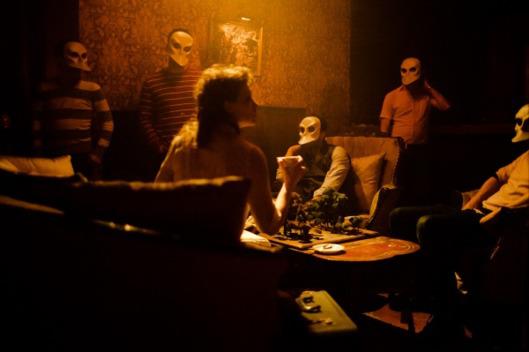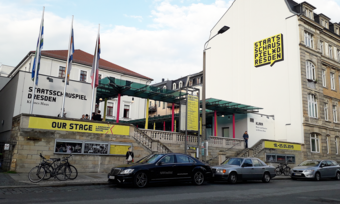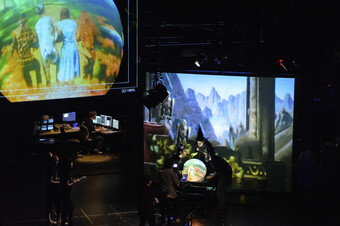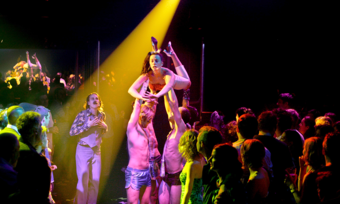Let Them Play
Most of us grew interested in theater because we loved to play games as children. I remember playing make-believe at eight years old with my neighbor Alan. We used felled tree branches as swords and talked to ourselves using language borrowed from our parents about what we were doing and how we were going to do it.
Alan and I were pirates on this day, and we had a huge challenge. Our free improvisation on being the most peaceful pirates to ever live (we looted food people didn’t need, like carrots and tomatoes) hit a snag. We were stuck in the backyard. Marooned pirates are useless pirates. Alan and I had never really faced this challenge before; we had never been pirates before. Just as I suggested we assume powers of flight, Alan put his stick in the ground and said “A sail.” Theater people have to be in touch with a sense of play. We keep alive the necessity to immerse ourselves in imaginary worlds in order to better understand our own. All too often as grown ups, we deny our audiences the chance to engage with our imaginary worlds as anything but observers. Sometimes we need them to put that stick in the ground.

While theater leaders continue to search for a new way to assess and improve the value we provide to audience members, WolfBrown conducted a national study to increase the field’s understanding of what seeing a piece of theater actually does to someone emotionally, intellectually and empathetically. The findings of that study are collected in Counting New Beans: Intrinsic Impact and the Value of Art. Intrinsic impact is a quantitative tool for bridging the divide between anecdote and analysis, of helping us all learn how to better serve our audiences by truly delivering transformative experiences to them. Clayton Lord, who oversaw the intrinsic impact work done by WolfBrown on behalf of Theater Bay Area, argues that we continue tracking our success as a field by a simple assessment of money in and money out at the risk of losing our story. Rather, certain controllable factors affect how deeply we impact our audience members. Anticipation (how much a patron looks forward to the theatrical experience) and Captivation (how absorbed a patron is during the theatrical experience) are both critical factors in determining summative impact.
Theater people have to be in touch with a sense of play. We keep alive the necessity to immerse ourselves in imaginary worlds in order to better understand our own. All too often as grown ups, we deny our audiences the chance to engage with our imaginary worlds as anything but observers. Sometimes we need them to put that stick in the ground.
In the WolfBrown study, captivation ratings accounted for almost half of the variability in impact. Therefore, what we do before the event and what we do to frame the event itself greatly affects how successful we are at making meaning. If we grow more successful at making meaning for patrons, at connecting with their hearts and engaging their minds, we have a shot at getting their friends into the theater. We have a shot at uncorking a latent communal desire to experience the transcendent, the epic, and the playful. We have a shot at getting people to not only try what we offer, but come back again and again to taste a revitalized and revitalizing well of what it means to be human. What then, are the useful ways to build anticipation and captivation?
Games and the theater field has a long history of delivering game-like experiences. Dancing and singing contests preceded dramatic performances in the Dionysia. Plays were performed alongside chariot races and animal hunts as part of the Roman Games. Tudor and Stuart masques called on courtly audiences to participate in the restoration of dramatic order by dancing with and among the performers. Back then, the boozy theatrical party continued into the wee hours of the morning. What then is a game? Broadly defined, games are voluntary attempts to overcome unnecessary obstacles. Game designer and performance studies doctorate Janie McGonigal goes a step further by suggesting games must have clear goals, established rules for action and the potential for increased difficulty and improvement over time. Dancing the tango, for instance, meets all of McGonigal’s criteria for a game. The goal is to move synchronistically with a partner for the duration of a song, the rules for action are the proscribed steps and the potential for improvement over time is what gives all of us with two left feet any reason to practice. Feedback happens in the form of a teacher’s instruction or a ruined date.
Recently, artists like Diane Paulus have played with game structures. The Karaoke Show mines its eponymous pop phenomenon to render a version of Shakespeare’s Comedy of Errors. Paulus and Randy Weiner have their audience enter the “Happy Twins Karaoke Lounge”, complete with song bibles on each cabaret table. Action is revealed through characters’ song choices. At the end of The Karaoke Show, the bar owner takes off her costume, revealing herself as the mother of the two twins who have miraculously found their way into her lounge. She then rocks out to ‘Sweet Child o’ Mine’ before the audience takes its turn onstage. Karaoke fits the game-form beautifully: the player sings a song to its completion with the feedback of a video screen tracking her progress.

The Karaoke Show extends the theatrical experience into an improvisational ether full of social potential and risk. Punchdrunk’s Sleep No More has become a cultural phenomenon by this point, even traversing into the pop lexicon with mentions on Gossip Girl and visits from Justin Timberlake and Kanye West. The show is an immersive, audience-guided journey through an intimate iteration of Macbeth. I was asked to wear a white plastic mask with an elongated jaw, as if a carnival mask and the Scream mask got together and had a very scary baby. The masks invited us to experience a decadent world through the anonymizing lens of an avatar. Participants are invited to interact with the rudimentary elements of an absorbing alternate reality: coffins, rolodexes, doors and people. Sleep No More ups the ante on the alternate reality game-form, like World of Warcraft’s sexy cousin. As with any great game, Punchdrunk’s show gives attendees compelling goals (I ran for my life a few times), interesting obstacles (like Duncan being murdered in a sheikh’s tent), and feedback (oftentimes from the actors themselves). Sleep No More surely offers all the biochemical benefits of flow, the goal game designers and theater makers both covet.
Similarly, this year’s Under the Radar Festival featured Gob Squad’s Kitchen (You’ve Never Had it So Good). Like much of Gob Squad’s work, the show mines the nexus of art, media and life. Participation was germane to the experience for those of us in attendance. In an attempt to loosely recreate and gently spoof the banal world of Andy Warhol’s films, the company invited audience members to walk around a Warhol-esque factory and to make screen tests. When I went, the screen tests ranged from awkward staring to silly impressions of Edie Sedgwick. During the performance, four audience volunteers repeated dialogue given through earpieces, with the immediate feedback of other audience members. Volunteers or not, we all experienced Gob Squad’s Kitchen as a captivating game that asks observers to make theater with the performers using the ingredients of reality.
All three examples share some aesthetic DNA. They are certainly all participatory shows, conceived to be so from the very beginning. They also were insanely successful by any critical or financial measure. These three shows and their numerous game-form kin make unlucky producers writhe in jealousy. It is no coincidence then that all three enjoyed a lot of repeat attendance, which is one of the outcomes of high captivation levels in the WolfBrown study. Via innovative form and stunning execution, all three productions enlivened audiences with a buffet of emotional and intellectual benefits. We celebrate these companies for their innovation and their ability to engage audiences, to captivate them in ways that break through the fourth wall. We all have this power.
The structures of institutional theater making do not excuse us from thinking about the captivating power of games. Sleep No More and Gob Squad’s Kitchen were, after all, presented by two of the oldest and largest regional theaters in the country. Ask Diane Paulus or Oskar Eustis if they would welcome the opportunity to program more experiences like these for their audiences. Our play development process favors the known, the calculable. It was built to justify our existence using extrinsic metrics, the metrics by which we have been judged for five decades and by which we are currently struggling as an industry. Our collective economic or educational impact is small enough that funders have started ignoring us more and more. Audiences are perpetually turning away from us. Why give them that choice? Let’s be so good they can’t ignore us.
Games In our rehearsal rooms and in our drama classes, we talk an awful lot about flow. Many of our techniques and exercises are a means of providing access to what Mihály Csíkszentmihályi described in his study Beyond Boredom and Anxiety as “the satisfying, exhilarating feeling of creative accomplishment and heightened functioning. “ Csíkszentmihályi spent seven years studying this form of joyous, intense engagement. His subjects found very little of it in daily life. Instead, flow was consistently produced by participating in game-like activities. Csíkszentmihályi discovered “games are an obvious source of flow and play is a flow inducing experience par excellence.” Flow defines an acute form of captivation and games are a form of access to that captivation. Psychologists have been studying how eustress affects our bodies for many years. They find that when we are optimistically invigorated by an activity, meaning when we are motivated and interested in a stressful situation, we experience all the key emotional states corresponding to well-being and life satisfaction. We are, in the words of Harvard professor Tal Ben-Shahar, “happier enlivening time rather than killing time.” Throw in the dopamine-producing benefits of collectively experienced phenomena, and games mirror the social benefits of theater. Both are powerful tools for structuring experience and provoking positive emotion. Combined, they may have more captivating potential than any other activities imaginable.
Humans are wired to derive significant intrinsic rewards from activities that have innate purpose. Game-forms provide innate purpose and theater provides the social connectivity necessary to make meaning. Happiness derived from intrinsic rewards is the most resilient form of happiness. By seeking out powerful live performances, we trigger our pilomotor reflex, flooding our minds with attentiveness and pleasure. Just like the individual patrons we serve, theaters will never run out of the raw materials for making our own happiness if we focus on intrinsic rewards. We can do this by reforming our play development strategies around the audience. This may be the way we keep funders interested in our work. An ethos of inclusion still leaves room for a Hamlet that devastates or a Book of Mormon that tickles. There is simply no replacement for the witness of great art. The game-form simply provides a tested structure for augmenting or complementing that, for answering the call to engage audiences or risk enraging them. If you can’t imagine creating a game-form play that brings the blue hairs to their knees and the youthquake to your doorstop, then at least frame what you already do in a way that creates anticipation. If you already programmed The Wizard of Oz for next year, consider sending potential attendees an email or text the day of the show letting them know the yellow brick road has been destroyed by the Wicked Witch of the West. You need their help putting it back together before showtime. Bricks are scattered all over the theater, in the scene shops and in the dressing rooms. Take those who accept your mission on an educational journey through your backstage and let them collect bricks along the way. Let your audience put the yellow brick road together for you just before the curtain rises. Let the game take over. Let them do exactly what we all intrinsically need to do. Let them play.
Happy sailing, pirates.








Comments
The article is just the start of the conversation—we want to know what you think about this subject, too! HowlRound is a space for knowledge-sharing, and we welcome spirited, thoughtful, and on-topic dialogue. Find our full comments policy here
Thanks for writing about the potential intersections with gaming and theater. I am fascinated by how individuals can work together to solve problems within a public arena. This is possibly where Jane McGonigal's vision intersects with performance, yet what is the tipping point between participation and witnessing? Theater can be terrifying and adults may not want to expose their pirate selves in public. This is where WolfBrown's "captivation" node may privilege an increased heart rate over an individual's thoughtfulness. While I appreciate dramatic climaxes, I treasure quiet theatrical moments. I admit I go to theater to observe rather than play.
Game structures used by musicians may be another way to influence live theater. I remember playing John Zorn's Cobra in the 1990s. Cobra features a "conductor" in a baseball cap who prompts musicians based on a predetermined set of cues. The most fun was when musicians would sabotage the prompts. Composers and bands such as Iannis Xenakis and Sonic Youth also used game theory to structure musical works. Knowing the rules, and oftentimes the performers, makes the play pleasurable. Perhaps the solution, as you mention, is if individuals get to choose their level of participation in the performance from anonymous bystander to active actor where everybody involved knows the rules of the game.
Good stuff to think about in here, Matthew. I'd love to hear you tease out a bit on how you see arts-based game structures (not just shows, but practices or processes) that take engagement and audience participation into civic applications...planners are doing it, health policy folks are exploring it, and it seems to me that science/innovation labs, when they crowdsource public intellectual capital, are using similar dynamics of anticipation and captivation. How does that market driven but open source approach to problem solving intersect with performance events seeking to engage and compel new 'users', i wonder, from your perspective...?